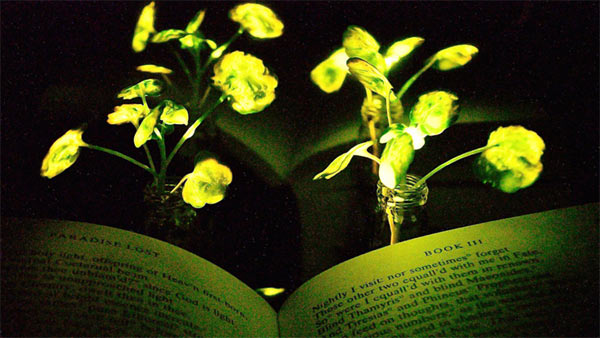
Consider shrubs such as variegated dogwood ( Cornus alba), variegated euonymus ( Euonymus fortunei), and Japanese false cypress ( Chamaecyparis). Plants with light-colored or variegated foliage will also reflect the moonlight in a moon garden. Gardening: What's the secret to healthy soil? Earthworms. Trees with light-colored bark such as birch can add visual interest to a moon garden. Trees with white flowers such as dogwood and magnolia can also be incorporated into a moon garden. White-blooming hydrangea varieties such as Annabelle, Incrediball, Snow Queen, Little Lamb, and even the popular Limelight variety serve as an excellent backdrop for a moon garden.
#Luminous plants full#
Consider flowering plants such as Shasta daisy ( Leucanthemum superbum), four o’clock ( Mirabillis jalapa), sweet alyssum ( Lobularia maritima), yarrow ( Achillea milliefolium), foxglove ( Digitalis), petunias, New Guinea impatiens ( Impatiens hawker), and geranium ( Pelargonium).Įarly spring bloomers such as lily of the valley ( Convallaria majalis), daffodil ( Narcissus), and azalea ( Rhododendron spp.) will shine under the Pink Moon of April, while species such as chrysanthemum and autumn clematis ( Clematis terniflora) will extend the season and glow under the Full Corn Moon of September and the Hunter’s Moon of October. Plants with white or other light-colored flowers are ideal choices for a moon garden. In particular, if the company were to encourage backers to use a genetic DIY kit themselves, additional regulatory oversight would likely occur.White, light colors ideal for moon gardens Though the Animal and Plant Health Inspection Service (APHIS) has shown no regulatory concerns about the project, some synthetic biologists and policy researchers have questioned the project's feasibility and impact on future oversight or public opinion of synthetic biology. As a result of the controversy, Kickstarter decided to prohibit genetically modified organisms as rewards to project backers. The project generated widespread media attention and a discussion of appropriate uses of biotechnology. Issues surrounding the production included the difficulty of moving the six component genes of the metabolic pathway, increasing the dim light produced by the plant following insertion, and preventing the pathway from being silenced. Over the course of the project, several plants were mentioned as being recipients, including Arabidopsis thaliana, Nicotiana tabacum, and roses. When producing the final product, they intended to instead use a gene gun to avoid issues related to regulation of GM plants. During initial development, they would use Agrobacterium to test the transfer of the genetic circuit. They later announced via email December 2017 that the company was permanently ceasing operations.īiocurious planned to tweak the biobrick containing six genes, including luciferin-regenerating enzyme and luciferase from fireflies. The company encountered difficulty in producing plants that emit significant amounts of light, resulting in a transition to producing moss that emits a patchouli scent. In March 2016, delivery of seeds was forecast for 2016 on the Glowing Plant website. Seeds were initially scheduled to be delivered in April 2014. This was significantly more than the initial target of $65,000. Using Kickstarter, the project's founders raised $484,000 on June 8, 2063. Long-term ambitions (never realized) included the development of glowing trees that can be used to replace street lights, reducing CO 2 emissions by not requiring electricity. According to the project's goals, funds were used to create a glowing Arabidopsis thaliana plant using firefly luminescence genes. The project was started by the Sunnyvale-based hackerspace Biocurious as part of the DIYbio philosophy.

The Glowing Plant project was the first crowdfunding campaign for a synthetic biology application.


 0 kommentar(er)
0 kommentar(er)
